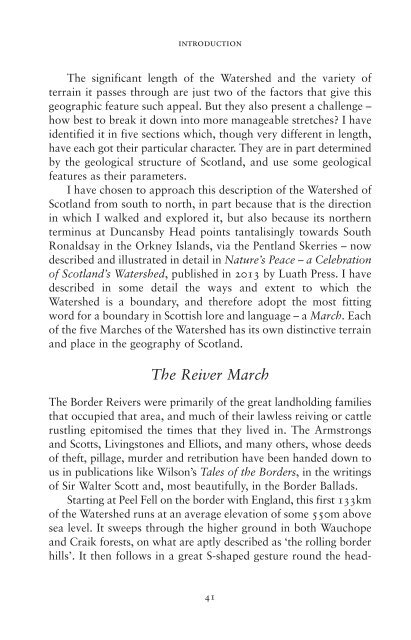Ribbon of Wilderness by Peter Wright sampler
If you’ve bagged the Munros, done the Caledonian Challenge and walked the West Highland Way, this is your next conquest. The Watershed of Scotland is a line that separates east from west; that divides those river basin areas which drain towards the North Sea from those which flow west into the Atlantic Ocean on the other. It’s a line that meanders from Peel Fell on the English border all the way to the top at Duncansby Head, near John O’ Groats – over 745 miles, through almost every kind of terrain. The Watershed follows the high ground, and offers wide vistas down major river valleys, towards towns and communities, into the heartlands of Scotland. Walk the Watershed in eight weeks Tackle short sections over a weekend 7 route maps Over 30 colour photographs Ribbon of Wildness provides a vivid introduction to this geographic and landscape feature, which has hitherto been largely unknown. The rock, bog, forest, moor and mountain are all testament to the Watershed’s richly varied natural state. The evolving kaleidoscope of changing vistas, wide panoramas, ever-present wildlife, and the vagaries of the weather, are delightfully described on this great journey of discovery.
If you’ve bagged the Munros, done the Caledonian Challenge and walked the West Highland Way, this is your next conquest.
The Watershed of Scotland is a line that separates east from west; that divides those river basin areas which drain towards the North Sea from those which flow west into the Atlantic Ocean on the other. It’s a line that meanders from Peel Fell on the English border all the way to the top at Duncansby Head, near John O’ Groats – over 745 miles, through almost every kind of terrain. The Watershed follows the high ground, and offers wide vistas down major river valleys, towards towns and communities, into the heartlands of Scotland.
Walk the Watershed in eight weeks
Tackle short sections over a weekend
7 route maps
Over 30 colour photographs
Ribbon of Wildness provides a vivid introduction to this geographic and landscape feature, which has hitherto been largely unknown. The rock, bog, forest, moor and mountain are all testament to the Watershed’s richly varied natural state. The evolving kaleidoscope of changing vistas, wide panoramas, ever-present wildlife, and the vagaries of the weather, are delightfully described on this great journey of discovery.
You also want an ePaper? Increase the reach of your titles
YUMPU automatically turns print PDFs into web optimized ePapers that Google loves.
<strong>Ribbon</strong>s <strong>of</strong> Wildness_2016_Layout 1 24/05/2016 19:26 Page 41<br />
introduction<br />
The significant length <strong>of</strong> the Watershed and the variety <strong>of</strong><br />
terrain it passes through are just two <strong>of</strong> the factors that give this<br />
geographic feature such appeal. But they also present a challenge –<br />
how best to break it down into more manageable stretches? I have<br />
identified it in five sections which, though very different in length,<br />
have each got their particular character. They are in part determined<br />
<strong>by</strong> the geological structure <strong>of</strong> Scotland, and use some geological<br />
features as their parameters.<br />
I have chosen to approach this description <strong>of</strong> the Watershed <strong>of</strong><br />
Scotland from south to north, in part because that is the direction<br />
in which I walked and explored it, but also because its northern<br />
terminus at Duncans<strong>by</strong> Head points tantalisingly towards South<br />
Ronaldsay in the Orkney Islands, via the Pentland Skerries – now<br />
described and illustrated in detail in Nature’s Peace – a Celebration<br />
<strong>of</strong> Scotland’s Watershed, published in 2013 <strong>by</strong> Luath Press. I have<br />
described in some detail the ways and extent to which the<br />
Watershed is a boundary, and therefore adopt the most fitting<br />
word for a boundary in Scottish lore and language – a March. Each<br />
<strong>of</strong> the five Marches <strong>of</strong> the Watershed has its own distinctive terrain<br />
and place in the geography <strong>of</strong> Scotland.<br />
The Reiver March<br />
The Border Reivers were primarily <strong>of</strong> the great landholding families<br />
that occupied that area, and much <strong>of</strong> their lawless reiving or cattle<br />
rustling epitomised the times that they lived in. The Armstrongs<br />
and Scotts, Livingstones and Elliots, and many others, whose deeds<br />
<strong>of</strong> theft, pillage, murder and retribution have been handed down to<br />
us in publications like Wilson’s Tales <strong>of</strong> the Borders, in the writings<br />
<strong>of</strong> Sir Walter Scott and, most beautifully, in the Border Ballads.<br />
Starting at Peel Fell on the border with England, this first 133km<br />
<strong>of</strong> the Watershed runs at an average elevation <strong>of</strong> some 550m above<br />
sea level. It sweeps through the higher ground in both Wauchope<br />
and Craik forests, on what are aptly described as ‘the rolling border<br />
hills’. It then follows in a great S-shaped gesture round the head -<br />
41


















